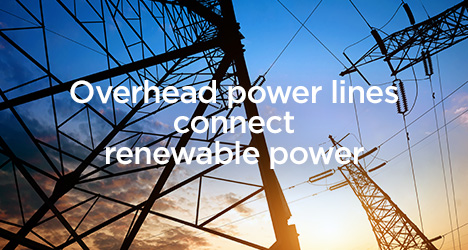Working with EPCs — End-to-End Renewable Energy Engineering Learn More
Overhead power lines connect renewable power to the grid

Blymyer Engineers designs transmission lines to connect substations to the electric power grid for many projects. These high-voltage lines carry the energy generated by renewable energy projects like solar farms to existing transmission infrastructure. They also designs the lower voltage lines that carry energy from generation assets to substations.
The role of transmission lines in the power grid
Transmission lines are a common part of the modern landscape. There are about 160,000 miles of high-voltage power lines in the United States. They carry power long distances. Local step-down substations convert power from transmission lines to lower voltages. From there, distribution lines carry that power to homes and businesses. But how does power get from utility-scale solar projects to users?
The individual photovoltaic arrays at utility-scale solar farms generate low-voltage power, which is too low a voltage to send directly to the grid. Utility-scale projects include step-up substations that collect this power and convert it to a higher voltage. Dedicated transmission lines tie the substations to the grid.
“Gen-tie is a common term for the overhead power lines we design,” explains Alexey Kondrashov, a senior electrical engineer with Blymyer. “That stands for generation tie line. Think of gen-ties as the superhighways that link all of us to the facilities that generate power. We use advanced software to model gen-tie transmission line designs so that they perform as expected in the field.”
Overhead vs. underground lines
Transmission lines can run overhead or underground. Each option has advantages and drawbacks. Underground lines are out of sight, which minimizes their visual impact. They are also protected by the earth from extreme weather. But the costs are much higher, and not just because of trenching and backfill. Underground lines need more insulation than overhead lines. That’s because overhead lines are cooled by their exposure to the air. Also, trenching is difficult across rough terrain and in densely populated areas.
Prairie Wolf Solar Project opts for overhead lines
The 200MW Prairie Wolf Solar Project provides an example of Blymyer’s power line design work. Prairie Wolf is located in Coles County, Illinois. SOLV Energy led the project and started construction on Prairie Wolf in February 2021 and completed construction in 2022. The Blymyer team designed overhead lines to connect the solar panels to the collecting step-up substation. To design the lines, Blymyer used PLS-CADD software from Power Line Systems. PLS-CADD lets the team model the project. They use it to optimize the structural aspects, such as the foundations for the poles.
“Usually, underground cables are used to connect the PV generation output to the substation,” says Jak Kuehn, a senior electrical engineer with Blymyer. “But at Prairie Wolf, we determined that overhead was the better option. Our software helps us understand our options and design the best solution for clients based on the site.”